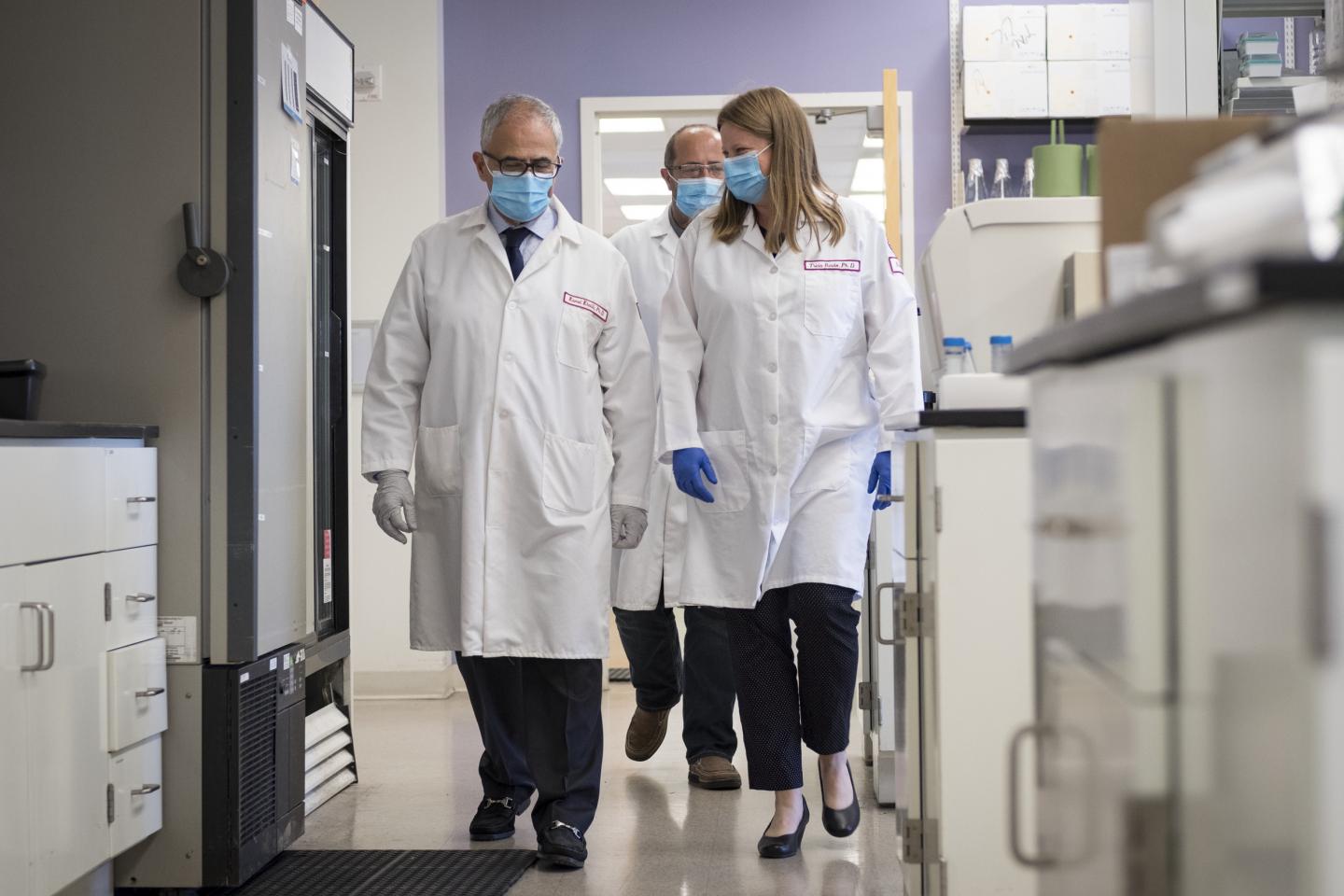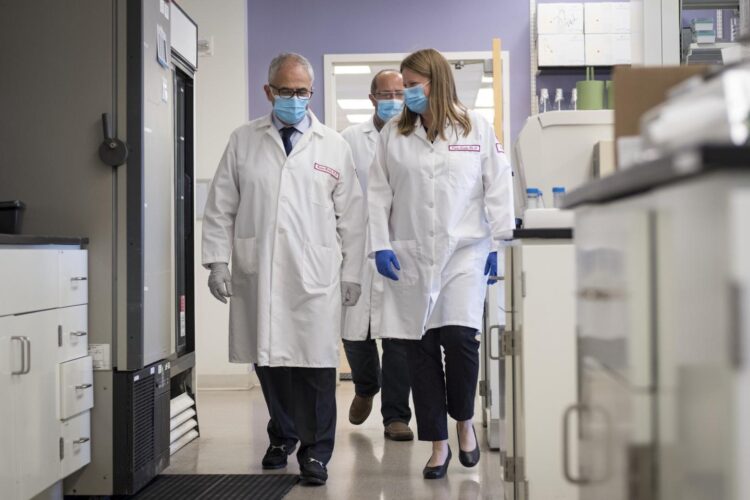Breakthrough brings Temple researchers and their collaborators closer to a cure for human HIV infection

Credit: Temple University
(Philadelphia, PA) – Taking a major step forward in HIV research, scientists at the Lewis Katz School of Medicine at Temple University have successfully edited SIV – a virus closely related to HIV, the cause of AIDS – from the genomes of non-human primates. The breakthrough brings Temple researchers and their collaborators closer than ever to developing a cure for human HIV infection.
“We show for the first time that a single inoculation of our CRISPR gene-editing construct, carried by an adeno-associated virus, can edit out the SIV genome from infected cells in rhesus macaque monkeys,” said Kamel Khalili, PhD, Laura H. Carnell Professor and Chair of the Department of Neuroscience, Director of the Center for Neurovirology, and Director of the Comprehensive NeuroAIDS Center at the Lewis Katz School of Medicine at Temple University (LKSOM).
Dr. Khalili was a senior co-investigator on the new study, with Tricia H. Burdo, PhD, Associate Professor and Associate Chair of Education in the Department of Neuroscience at LKSOM, who is an expert on the utilization of the SIV (simian immunodeficiency virus)-infected antiretroviral therapy (ART)-treated rhesus macaque model for HIV pathogenesis and cure studies; and with Andrew G. MacLean, PhD, Associate Professor at the Tulane National Primate Research Center and the Department of Microbiology and Immunology at Tulane University School of Medicine, and Binhua Ling, PhD, Associate Professor at the Southwest National Primate Research Center, Texas Biomedical Research Institute. Dr. Ling was previously Associate Professor at the Tulane National Primate Research Center and the Department of Microbiology and Immunology at Tulane University School of Medicine. Pietro Mancuso, PhD, an Assistant Scientist in Dr. Khalili’s laboratory in the Department of Neuroscience at LKSOM, was first author on the report, which was published online November 27 in the journal Nature Communications.
Of particular significance, the new work shows that the gene-editing construct developed by Dr. Khalili’s team can reach infected cells and tissues known to be viral reservoirs for SIV and HIV. These reservoirs, which are cells and tissues where the viruses integrate into host DNA and hide away for years, are a major barrier to curing infection. SIV or HIV in these reservoirs lies beyond the reach of ART, which suppresses viral replication and clears the virus from the blood. As soon as ART is stopped, the viruses emerge from their reservoirs and renew replication.
In non-human primates, SIV behaves very much like HIV. “The SIV-infected rhesus macaque model studied in Dr. Burdo’s lab is an ideal large animal model for recapitulating HIV infection in humans,” explained Dr. Khalili.
For the new study, the researchers began by designing an SIV-specific CRISPR-Cas9 gene-editing construct. Experiments in cell culture confirmed that the editing tool cleaved integrated SIV DNA at the correct location from host cell DNA, with limited risk of potentially harmful gene editing at off-target sites. The research team then packaged the construct into an adeno-associated virus 9 (AAV9) carrier, which could be injected intravenously into SIV-infected animals.
Dr. Burdo, in collaboration with colleagues at Tulane National Primate Research Center, randomly selected three SIV-infected macaques to each receive a single infusion of AAV9-CRISPR-Cas9, with another animal serving as a control. After three weeks, the researchers harvested blood and tissues from the animals. Analyses showed that in AAV9-CRISPR-Cas9-treated macaques, the gene-editing construct had been distributed to a broad range of tissues, including the bone marrow, lymph nodes, and spleen, and had reached CD4+ T cells, which are a significant viral reservoir.
Moreover, the Temple researchers demonstrated that the SIV genome was effectively cleaved from infected cells, based on genetic analyses of tissues from treated animals. “The step-by-step excision of SIV DNA occurred with high efficiency from tissues and blood cells,” Dr. Mancuso explained. Excision efficiency varied by tissue but reached notably high levels in the lymph nodes.
The new study is a continuation of efforts by Dr. Khalili and colleagues to develop a novel gene-editing system using CRISPR-Cas9 technology – the subject of the 2020 Nobel Prize in Chemistry – to specifically remove HIV DNA from genomes harboring the virus. The researchers have shown previously that their system can effectively eliminate HIV DNA from cells and tissues in HIV-infected small animal models, including HIV-1 humanized mice.
Co-corresponding author Dr. MacLean is encouraged by the findings. “This is an important development in what we hope will be an end to HIV/AIDS,” says MacLean. “The next step is to evaluate this treatment over a longer period of time to determine if we can achieve complete elimination of the virus, possibly even taking subjects off of ART.”
Dr. MacLean is hopeful that this treatment strategy will translate to the human population. The biotech company Excision BioTherapeutics, of which Dr. Khalili is a scientific founder and where Dr. Burdo contributes to preclinical research and development and serves on the Scientific Advisory Board, will assist with funding and infrastructure for larger scale studies and future clinical trials after approval by the Food and Drug Administration.
“We hope to soon move our work into clinical studies in humans as well,” Dr. Khalili added. “People worldwide have been suffering with HIV for 40 years, and we are now very near to clinical research that could lead to a cure for HIV infection.”
###
Other researchers contributing to the study include Chen Chen, Dr. Rafal Kaminski, Dr. Jennifer Gordon, Dr. Shuren Liao, Jake A. Robinson, Mandy D. Smith, Dr. Hong Liu, Dr. Ilker K. Sariyer, Rahsan Sariyer, and Dr. Martina Donadoni, Department of Neuroscience, Center for Neurovirology, Lewis Katz School of Medicine at Temple University; the late Dr. Tiffany A. Peterson, Jaclyn B. Williams, and Summer Siddiqui, Division of Comparative Pathology at the Tulane National Primate Research Center; and Dr. Bruce A. Bunnell, Division of Comparative Pathology at the Tulane National Primate Research Center, the Tulane Brain Institute, the Department of Pharmacology at Tulane University School of Medicine, and the Department of Microbiology, Immunology and Genetics at the University of North Texas Health Science Center, Fort Worth.
The research was supported in part by National Institutes of Health grants P51OD11104, P30MH092177, R01NS104016, R56AI143647, R56AI150772, U42OD024282, and U42OD010568.
Editor’s Note: Kamel Khalili is Co-Founder and Chief Scientific Consultant, and holds equity in Excision Biotherapeutics, which has licensed the viral gene editing technology from Temple University. Kamel Khalili and Rafal Kaminski are named inventors on patents that cover the viral gene editing technology. Tricia Burdo and Jennifer Gordon hold equity in Excision Biotherapeutics. These named researchers are employed by Temple University, and conduct research activities sponsored by the company.
Questions regarding their affiliations with Temple University may be directed to [email protected].
In addition to owning the viral gene editing technology that Excision is licensing, Temple University also holds an equity interest in Excision. As a result of these interests, Temple University could ultimately potentially benefit financially from the outcome of this research. These interests have been reviewed and approved by Temple University in accordance with its Institutional Conflict of Interest policy.
Questions about this can be directed to [email protected].
About Temple Health
Temple University Health System (TUHS) is a $2.2 billion academic health system dedicated to providing access to quality patient care and supporting excellence in medical education and research. The Health System consists of Temple University Hospital (TUH); TUH-Episcopal Campus; TUH-Jeanes Campus; TUH-Northeastern Campus; The Hospital of Fox Chase Cancer Center and Affiliates, an NCI-designated comprehensive cancer center; Temple Transport Team, a ground and air-ambulance company; Temple Physicians, Inc., a network of community-based specialty and primary-care physician practices; and Temple Faculty Practice Plan, Inc., TUHS’s physician practice plan comprised of more than 500 full-time and part-time academic physicians in 20 clinical departments. TUHS is affiliated with the Lewis Katz School of Medicine at Temple University.
Temple Health refers to the health, education and research activities carried out by the affiliates of Temple University Health System (TUHS) and by the Katz School of Medicine. TUHS neither provides nor controls the provision of health care. All health care is provided by its member organizations or independent health care providers affiliated with TUHS member organizations. Each TUHS member organization is owned and operated pursuant to its governing documents.
It is the policy of Temple University Health System that there shall be no exclusion from, or participation in, and no one denied the benefits of, the delivery of quality medical care on the basis of race, ethnicity, religion, sexual orientation, gender, gender identity/expression, disability, age, ancestry, color, national origin, physical ability, level of education, or source of payment.
Media Contact
Jeremy Walter
[email protected]
Original Source
https:/
Related Journal Article
http://dx.






